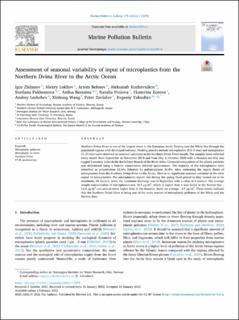| dc.contributor.author | Zhdanov, Igor | |
| dc.contributor.author | Lokhov, Alexey | |
| dc.contributor.author | Belesov, Artem | |
| dc.contributor.author | Kozhevnikov, Alexander | |
| dc.contributor.author | Pakhomova, Svetlana | |
| dc.contributor.author | Berezina, Anfisa | |
| dc.contributor.author | Frolova, Natalia | |
| dc.contributor.author | Kotova, Ekaterina | |
| dc.contributor.author | Leshchev, Andrey | |
| dc.contributor.author | Wang, Xinhong | |
| dc.contributor.author | Zavialov, Peter | |
| dc.contributor.author | Yakushev, Evgeniy | |
| dc.date.accessioned | 2022-07-12T14:13:03Z | |
| dc.date.available | 2022-07-12T14:13:03Z | |
| dc.date.created | 2022-05-18T11:11:41Z | |
| dc.date.issued | 2022 | |
| dc.identifier.citation | Marine Pollution Bulletin. 2022, 175, 113370. | en_US |
| dc.identifier.issn | 0025-326X | |
| dc.identifier.uri | https://hdl.handle.net/11250/3004701 | |
| dc.description.abstract | Northern Dvina River is one of the largest rivers in the European Arctic flowing into the White Sea through the populated regions with developed industry. Floating plastics include microplastics (0.5–5 mm) and mesoplastics (5–25 mm) were observed on seasonal variations in the Northern Dvina River mouth. The samples were collected every month from September to November 2019 and from May to October 2020 with a Neuston net that was togged 3 nautical miles in the Korbel'nyy Branch of the River delta. Chemical composition of the plastic particles was determined using a Fourier transmission infrared spectrometer. The majority of the microplastics were identified as polyethylene 52.6%, followed by polypropylene 36.8%. After estimating the export fluxes of microplastics from the Northern Dvina River to the Arctic, there is no significant seasonal variation of the river export of microplastics. The microplastics export rate during the spring flood period in May turned out to be maximum, 58 items/s, while the minimum discharge was in September with a value of 9 items/s. The average weight concentration of microplastics was 18.5 μg/m3, which is higher than it was found in the Barents Sea – 12.5 μg/m3 and several times higher than in the Eurasian Arctic on average - 3.7 μg/m3. These results indicate that the Northern Dvina River is being one of the main sources of microplastic pollution of the White and the Barents Seas. | en_US |
| dc.language.iso | eng | en_US |
| dc.publisher | Elsevier | en_US |
| dc.rights | Navngivelse 4.0 Internasjonal | * |
| dc.rights.uri | http://creativecommons.org/licenses/by/4.0/deed.no | * |
| dc.title | Assessment of seasonal variability of input of microplastics from the Northern Dvina River to the Arctic Ocean | en_US |
| dc.type | Peer reviewed | en_US |
| dc.type | Journal article | en_US |
| dc.description.version | publishedVersion | en_US |
| dc.rights.holder | © 2022 The Authors | en_US |
| dc.source.pagenumber | 7 | en_US |
| dc.source.volume | 175 | en_US |
| dc.source.journal | Marine Pollution Bulletin | en_US |
| dc.identifier.doi | 10.1016/j.marpolbul.2022.113370 | |
| dc.identifier.cristin | 2025112 | |
| dc.source.articlenumber | 113370 | en_US |
| cristin.ispublished | true | |
| cristin.fulltext | original | |
| cristin.qualitycode | 1 | |

